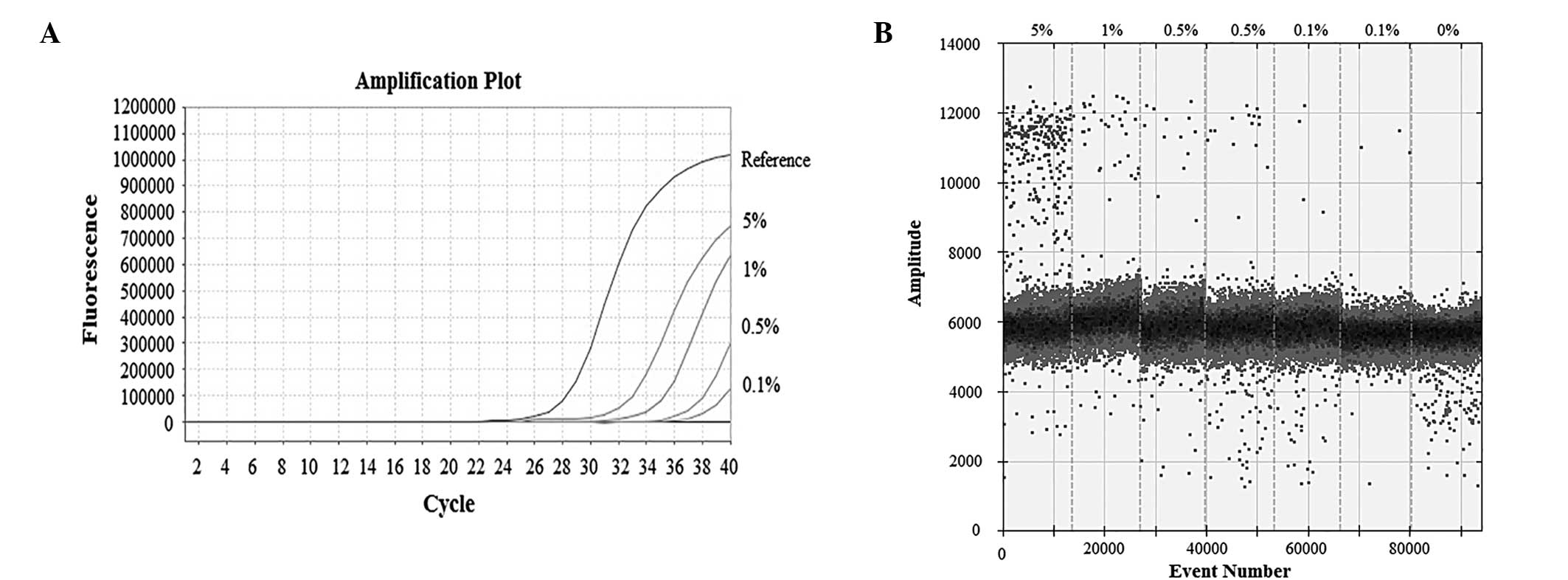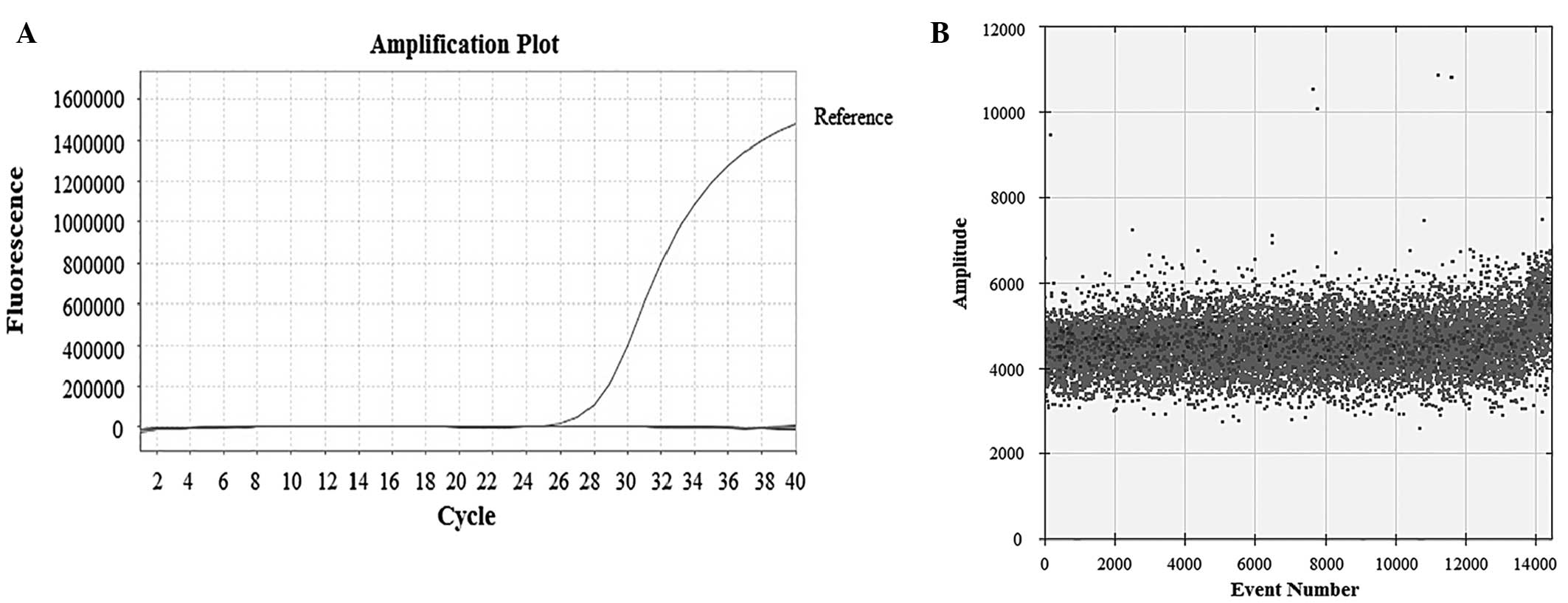|
1
|
Bai H, Mao L, Wang HS, et al: Epidermal
growth factor receptor mutations in plasma DNA samples predict
tumor response in Chinese patients with stages IIIB to IV
non-small-cell lung cancer. J Clin Oncol. 27:2653–2659. 2009.
View Article : Google Scholar : PubMed/NCBI
|
|
2
|
Franklin WA, Veve R, Hirsch FR, Helfrich
BA and Bunn PA Jr: Epidermal growth factor receptor family in lung
cancer and premalignancy. Semin Oncol. 29(1 Suppl 4): 3–14. 2002.
View Article : Google Scholar : PubMed/NCBI
|
|
3
|
Wang J, Ramakrishnan R, Tang Z, et al:
Quantifying EGFR alterations in the lung cancer genome with
nanofluidic digital PCR arrays. Clin Chem. 56:623–632. 2010.
View Article : Google Scholar : PubMed/NCBI
|
|
4
|
Sharma SV, Bell DW, Settleman J and Haber
DA: Epidermal growth factor receptor mutations in lung cancer. Nat
Rev Cancer. 7:169–181. 2007. View
Article : Google Scholar : PubMed/NCBI
|
|
5
|
Fukuoka M, Yano S, Giaccone G, et al:
Multi-institutional randomized phase II trial of gefitinib for
previously treated patients with advanced non-small-cell lung
cancer (The IDEAL 1 Trial) [corrected]. J Clin Oncol. 21:2237–2246.
2003. View Article : Google Scholar : PubMed/NCBI
|
|
6
|
Kris MG, Natale RB, Herbst RS, et al:
Efficacy of gefitinib, an inhibitor of the epidermal growth factor
receptor tyrosine kinase, in symptomatic patients with non-small
cell lung cancer: a randomized trial. JAMA. 290:2149–2158. 2003.
View Article : Google Scholar : PubMed/NCBI
|
|
7
|
Shepherd FA, Rodrigues Pereira J, Ciuleanu
T, et al: Erlotinib in previously treated non-small-cell lung
cancer. N Engl J Med. 353:123–132. 2005. View Article : Google Scholar : PubMed/NCBI
|
|
8
|
Yamada T, Azuma K, Muta E, et al: EGFR
T790M mutation as a possible target for immunotherapy;
identification of HLA-A*0201-restricted T cell epitopes derived
from the EGFR T790M mutation. PLoS One. 8:e783892013. View Article : Google Scholar : PubMed/NCBI
|
|
9
|
Hirsch FR, Varella-Garcia M, Bunn PA Jr,
et al: Molecular predictors of outcome with gefitinib in a phase
III placebo-controlled study in advanced non-small-cell lung
cancer. J Clin Oncol. 24:5034–5042. 2006. View Article : Google Scholar : PubMed/NCBI
|
|
10
|
Pao W and Ladanyi M: Epidermal growth
factor receptor mutation testing in lung cancer: searching for the
ideal method. Clin Cancer Res. 13:4954–4955. 2007. View Article : Google Scholar : PubMed/NCBI
|
|
11
|
Kimura H, Kasahara K, Kawaishi M, et al:
Detection of epidermal growth factor receptor mutations in serum as
a predictor of the response to gefitinib in patients with
non-small-cell lung cancer. Clin Cancer Res. 12:3915–3921. 2006.
View Article : Google Scholar : PubMed/NCBI
|
|
12
|
Whale AS, Huggett JF, Cowen S, et al:
Comparison of microfluidic digital PCR and conventional
quantitative PCR for measuring copy number variation. Nucleic Acids
Res. 40:e822012. View Article : Google Scholar : PubMed/NCBI
|
|
13
|
Yung TK, Chan KC, Mok TS, Tong J, To KF
and Lo YM: Single-molecule detection of epidermal growth factor
receptor mutations in plasma by microfluidics digital PCR in
non-small cell lung cancer patients. Clin Cancer Res. 15:2076–2084.
2009. View Article : Google Scholar : PubMed/NCBI
|
|
14
|
Nagai Y, Miyazawa H, Huqun, et al: Genetic
heterogeneity of the epidermal growth factor receptor in non-small
cell lung cancer cell lines revealed by a rapid and sensitive
detection system, the peptide nucleic acid-locked nucleic acid PCR
clamp. Cancer Res. 65:7276–7282. 2005. View Article : Google Scholar : PubMed/NCBI
|
|
15
|
Thomas RK, Nickerson E, Simons JF, et al:
Sensitive mutation detection in heterogeneous cancer specimens by
massively parallel picoliter reactor sequencing. Nat Med.
12:852–855. 2006. View
Article : Google Scholar : PubMed/NCBI
|
|
16
|
Zhou Q, Zhang XC, Chen ZH, et al: Relative
abundance of EGFR mutations predicts benefit from gefitinib
treatment for advanced non-small-cell lung cancer. J Clin Oncol.
29:3316–3321. 2011. View Article : Google Scholar : PubMed/NCBI
|
|
17
|
Shigaki H, Baba Y, Watanabe M, et al:
PIK3CA mutation is associated with a favorable prognosis among
patients with curatively resected esophageal squamous cell
carcinoma. Clin Cancer Res. 19:2451–2459. 2013. View Article : Google Scholar : PubMed/NCBI
|
|
18
|
Janjigian YY, Tang LH, Coit DG, et al: MET
expression and amplification in patients with localized gastric
cancer. Cancer Epidemiol Biomarkers Prev. 20:1021–1027. 2011.
View Article : Google Scholar : PubMed/NCBI
|
|
19
|
Azuara D, Ginesta MM, Gausachs M, et al:
Nanofluidic digital PCR for KRAS mutation detection and
quantification in gastrointestinal cancer. Clin Chem. 58:1332–1341.
2012. View Article : Google Scholar : PubMed/NCBI
|
|
20
|
Gutiérrez C, Rodriguez J, Patiño-García A,
García-Foncillas J and Salgado J: KRAS mutational status analysis
of peripheral blood isolated circulating tumor cells in metastatic
colorectal patients. Oncol Lett. 6:1343–1345. 2013.
|
|
21
|
Marchetti A, Del Grammastro M, Felicioni
L, et al: Assessment of EGFR mutations in circulating tumor cell
preparations from NSCLC patients by next generation sequencing:
Toward a real-time liquid biopsy for treatment. PLoS One.
9:e1038832014. View Article : Google Scholar : PubMed/NCBI
|
|
22
|
Mostert B, Jiang Y, Sieuwerts AM, et al:
KRAS and BRAF mutation status in circulating colorectal tumor cells
and their correlation with primary and metastatic tumor tissue. Int
J Cancer. 133:130–141. 2013. View Article : Google Scholar
|











